 Do You know the Marine pieces?
Do You know the Marine pieces?
(Part I – Siren, Triton, Nereid)
IGM Petko Petkov
INTRODUCTION
This article is dedicated to the six special pieces in a fairy chess called Marine pieces: Siren (the Marine Queen = SI), Triton (The Marine Rook = TR), Nereid (The Marine Bishop=ND), Poseidon (The Marine King=PO), Marine Knight (=MK) and Marine Pawn (= MP).
With the cited 6 “classical” Marine pieces it is possible to play so called “Marine Chess” – a practical game which is rather similar to some very old and also to some relatively new variations of Chinese chess. On this basis we can conclude some similarities between the Chinese LEO, PAO, VAO and Siren, Triton and Nereid for example.
In my opinion, it is impossible to say for sure who is the inventor of the Marine pieces – there are some published problems with this material even before 1930! Some known composers from Italy, England, France, etc. have actively worked on this arena. But this article won’t discuss the historical questions.
The 1st part of the article will discuss the most popular three Marine pieces: Siren (the Marine Queen = SI), Triton (The Marine Rook = TR) and Nereid (The Marine Bishop=ND).
In his “Fairings” (N 25/2012) Chris Feather gives the following definition for these pieces:
“Siren SI/ Triton TR / Nereid ND: move as Q/R/B respectively, but capture by hopping over and removing an adverse unit, landing on the next (necessarily empty) square, i.e. they capture like the corresponding Locusts“.
Siren, Triton and Nereid are implemented in both of the most popular solving programs, Popeye and WinChloe, so either of them can be used for testing your problems with these pieces.
This article won’t demonstrate problems with any other fairy pieces and fairy conditions. Therefore, let’s see how Siren, Triton and Nereid can play – together and separately.
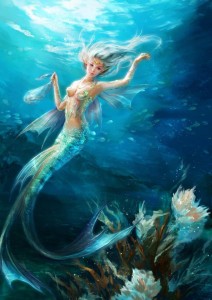 I. SIREN
I. SIREN
First, let’s see a few examples with a most powerful and interesting Marine piece, the Siren. A more elementary definition is: a piece that plays as a Queen but captures only as a Locust!
In a good problem with a Siren, it is obligatory to demonstrate very strongly the following two thematic effects: a) Queen-moves; b) Locust-captures.
The lovely thematic on this arena are of course different batteries (white or black) where the Siren plays very actively as a forward or rear battery-piece. Very interesting are the “Reciprocal Double batteries” created by two Sirens standing on the one thematic-line! For example: black Ke5, white Sirens d5 and f5. This mechanism is well known with the standard Locusts on d5 / e5, but created by Sirens, it has a “nuclear” power!!
It is important also to mark, that a Siren has extreme power in comparison with a Locust. Of course, this “Marine effect” gives many new possibilities, but if we play with neutral Sirens, the situation is rather difficult.
Example N 1 (probably one of the oldest problems with Siren), demonstrates some elementary rules and effects.
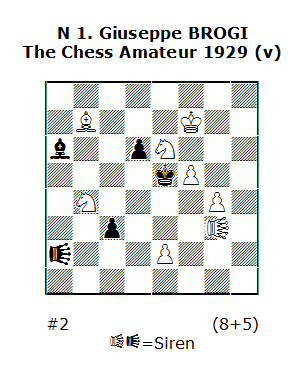
In the initial setting the b.King is not under “check” from SIg4 because the square “d6” is occupied. After 1.SIe3! – the threat is 2.SId4# , because the square f6 is free. Another effect of the key-move is the creation of the white battery Se6/SIe3, where Se6 is a forward battery-piece of course. But Se6 can not play immediately because it is pinned by the black SIa2!
Variations: 1…SId2! – now 2.SId4+? is false because of SId2xd4-d5. But now Se6 is unpinned and there follows: 2.Sf4#! – this move blocks square “f4” and prevents the defense SIxe3-f4. 1…SIxe2-e2! 2.Sd4#! – another block of square “d4” (impossible is LIxe3-d4). 1…SId5 2.Sc6# – a nice SI-block on “d5”! 1…SIc4 2.Sd3# – line-closing of the Ba6; 1…d5 2.SIf4# – the square “d6” is unblocked!

In N 2 the black Qd5 is pinned in the diagram position by both white Sirens. Setplay: 1…c4 2.SIb6#, 1…e4 2.SIf6#. 1.SIa8? [2.SIxd5-e4#] – 1…c4 2.SIa7#, 1…e4 2.SIa1#, but 1…b4! 1.SIh4+? – 1…c4 2.SIhf2#, 1…e4 2.SIf6#, but 1…Sg4! Solution: 1.SIg8! [2.SIxd5-c4#] – 1…c4 2.SIg1#, 1…e4 2.SIg7#. Here we see the well known orthodox theme Zagoruiko in its “Super-form” – 4 phase changed play. But it is obvious that here the white Sirens play rather “orthodoxically” – almost as white Queens. Another minus here are the black Pawn defenses, which don’e have full “Siren effects”.
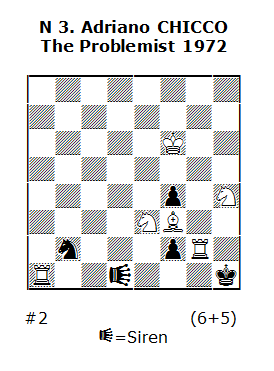
In N 3 after 1.Sf1! (2. Rg4#!) the black Siren d1 is unpinned. There follows three typical variations with double checks and blocks of the black checking Siren: 1…SId8+ 2.Rg5#!, 1…SId6+ 2.Rg6#!, 1…SId4+ 2.Rg7#! (1…SId5,SIxf3-g4 2.Sg3#, 1…SIxf1-g1 2.Rxf2#, 1…SIb3,SId3 2.Rg3,Sg3#).
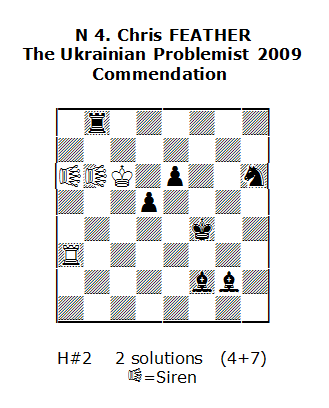
N 4 has a very interesting motive: in the initial setting White cannot create batteries SI/R because the squares f3 and g3 are free – for example: 1….SIb3? but now the move 2.Ke3?? is illegal because the self-check from SIb3. Analogically: 1…SId3? 2. Kf3?? (self-check from SId3). Black should block the squares f3/g3 with his first moves: I. 1.Bf3! SIb3 2.Ke3! SIb4#; II. 1.Bg3! SId3 2.Kf3 SIc4#.
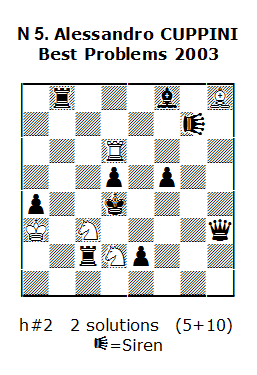
The author of N 5 uses a standard h#2 mechanism, well known from the orthodox H#2. I. 1.Kc5 Rb6 2.SIg3 Sxa4#; II. 1.Kd3 Sd1 2.SIe7 Rxd5#.
But this problem has a major weakness – the black SIg7 here doesn’t play as a typical “Marine Queen” – it is clear that SIg7 can be replaced with a black Pao!
The following absolutely analogical solutions are possible in this case: I. 1.Kc5 Rb6 2.PAg3 Sxa4#; II. 1.Kd3 Sd1 2.PAe7 Rxd5# (C+).
Therefore, here SIg7 plays a pseudo-thematic (not “Marine”) role – with no demonstration of typical Siren effects. Such errors should not be allowed, regardless of the genre in which the composer works.
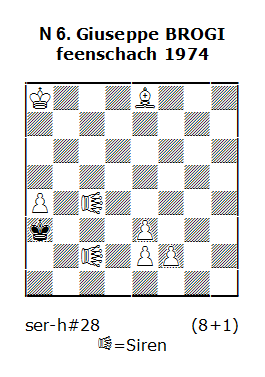
An interesting idea is demonstrated in N 6 – it is obvious that the black King can get to the square c3 in two moves: 1.Kb4 and 2.Kc3. After that we see on the board a double white battery SIc2/SIc4 but it cannot immediately be used, for example: 2…SIc5+? 3.Kd2!; 2…SI4d3+? 3.Kb4! etc. Therefore follows a long action of the black King with the standard goal – Annihilation of the white Pawns and wBe8: 1.Kb4 2.Kc3 3.Kd2 4.Ke1 5.Kxf2 6.Kg3 7.Kh4 8.Kg5 9.Kf6 10.Ke7 11.Kxe8 12.Ke7 13.Kf6 14.Kg5 15.Kh4 16.Kg3 17.Kf2 18.Kxe3 19.Kd2 20.Kc3 21.Kb4 22.Kxa4 23.Ka3 24.Ka2 25.Kb1 26.Kc1 27.Kd2 28.Kc3 SIc1#! – now the defenses 29.Kd2?? or 29.Kb4?? are not possible because of the illegal self-checks – the squares “a4” and “e3” are free!
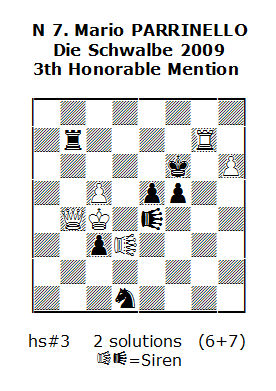
The Siren shows a lot of new possibilities in the hs# genre. A nice demonstration is N 7 – I.1.SIh3 SIg2 2.Qb1 SIg6 3.Qxf5+ SIxf5-e4#; II. 1.SIg3 SIc6 2.Qxc3 SIe8 3.Qxe5+ SIxe5-e4#. Unpins of the white Queen which is then sacrificed on the last move. The black Siren answers with good circuits, mating from its initial square “e4”. It has good contents but nevertheless the repetition of the mating moves is not quite acceptable. In this respect it would probably be better to try schemes with two black Sirens as thematic pieces. GM Mario Parrinello has many wonderful hs# problems with use of Marine pieces!
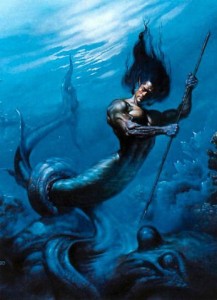 II. TRITON
II. TRITON
A more elementary definition of Triton is: a piece that plays as a Rook but captures only as a Locust!
There are few good examples where we can see only Triton and no other fairy pieces on the board, with the content still being sufficiently interesting.
The best example of this type is N 8. Pay attention here, that in the diagram position 1.TRe3#?? is not mate, because the square e5 is blocked! Set-play: 1…S~ (a) 2.f3# (A), 1…Sf3! (b) 2.d3# (B), 1…Sd3! (c) 2.TRxd3-e3# (C). Real play: 1.TRg3! – zz – 1…S~ (a) 2.d3# (B), 1…Sf3! (b) 2.TRxf3-e3# (C), 1…Cd3! (c) 2.f3# (A). An unique realization of Lacny theme, that shows also black Correction, black self-blocks and sacrifices of the bS on d3/f3, plus model mates in Meredith form!
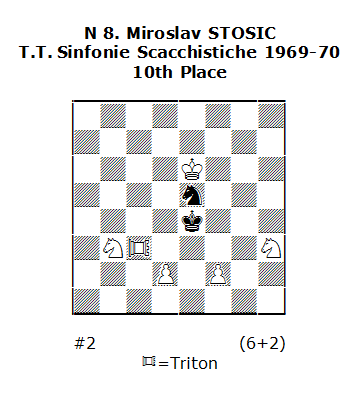
Unfortunately, this mechanism is well known from orthodox two-movers, where analogical complexes are realized many times, but without such brilliance as in N 8.
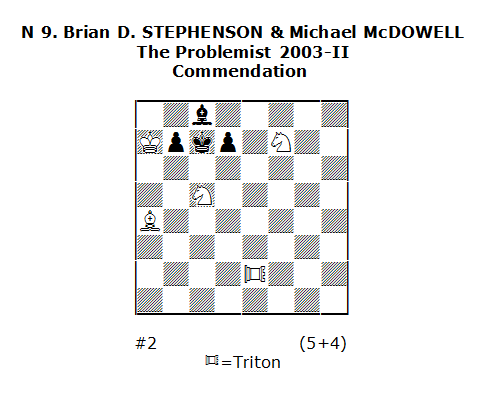
N 9 is another nice example, that shows beautifully the specific power of the white Triton. 1.TRe7? – zz 1…Pd7~ (a) 2.Sa6# (A), 1…b6 (b) 2.Se6# (B) but 1…b5! 1.TRc2! – zugzwang: 1…Pd~ (a) 2.Se6# (B) 1…Pb7~ b 2.Sa6# (A). Reciprocal change of mates, combined with very interesting pins of the black Pawns (in the first phase) and of the black Bc8 in the solution!
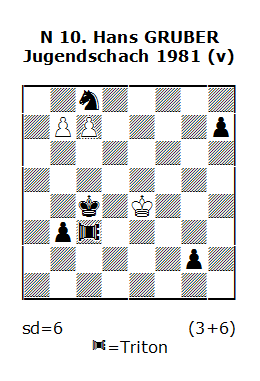
A surprising “Rundlauf” is demonstrated in the Series direct stalemate (sd=6) N 10: 1.b8=TR 2.TRxb3-b2 3.TRxg2-h2 4.TRxh7-h8 5.TRxc8-b8 6.c8=TR= – a finale with pinned TRc3!
 III. NEREID
III. NEREID
A more elementary definition of Nereid is: a piece that plays as a Bishop but captures only as a Locust!
The number of problems where Nereid(ND) plays on the board without any help from other fairy pieces is small. Nereid is a relatively low piece – it shows itself better in combination with other fairy pieces.
In N 11 there is a double battery, created from NDd2 and NDb4. The solutions: I.1.Qg1! Rxg1+ 2.NEc1+! Kxb4#; II. 1.Qa8! Rxa8+ 2.NEa3+! Kxd2#. Here the play of double battery is combined with ND pins, Q sacrifices and model mates. Of course, it is only a little demonstration of ND possibilities, in such battery-from not examined till now. Therefore, N 11 is probably only a work-scheme that deserves attention.
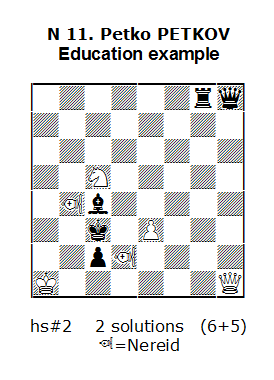
N 12 is a lovely demonstration of Feather’s theme – set-play where a neutral Pawn gives a mate immediately through promotion, and a long solution in which the same Pawn is promoted on the first rank. 1…b8=nND#; 1-4.bxa2 5.a1=nND 6.nNDxb2-c3 7.nNDd2 8.nNDe3 9.nNExf2-g1 10 – 11.f1=ND! 12.NDh3 13.NDxf5-e6 14.NDd5 NDb8#. A very interesting and difficult solution that demonstrates promotions to neutral ND and black ND plus a surprising block on “d5”!
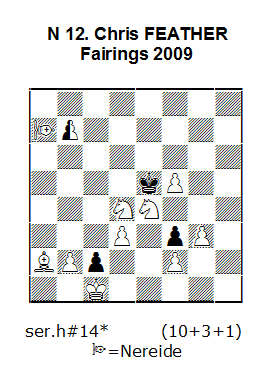
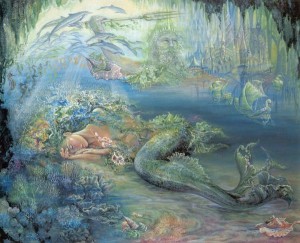 IV. COMBINATIONS BETWEEN MARINE PIECES
IV. COMBINATIONS BETWEEN MARINE PIECES
In modern practice fairy composers combine Marine pieces in the one problem. Of course, a lot of other combinations of Marine pieces with many other fairy pieces are possible!
But in all cases the composer should stick to the following principles:
A) Use Marine pieces only as thematic pieces, not only as technical material!
B) If in a problem you can use either Siren or Locust, you should choose a weaker figure – Locust! This is an expression of the principle of “Economy of force”. Similarly, you should use Rook Locust instead of Triton; Bishop Locust instead of Nereid!
Theoretically, the following combinations are possible between Siren, Triton and Nereid:
1. Siren + Triton + Nereid (It means that all these types of pieces are used in a problem)
2. Siren + Triton
3. Siren + Nereid
4. Triton + Nereid
In the thematic aspect in cases 1-4 I recommend using the various types of batteries: play of batteries (for example – with forward piece ND and rear piece Triton); creation of Marine batteries (a very fruitful method if you create reciprocal Marine batteries); destruction of Marine batteries (in combination with other thematic motives, for example: self-pins, Annihilation captures, etc).
Double Marine batteries combined with other Marine pieces are very interesting and powerful, especially in variations SI/SI, TR/TR; the duo ND/ND gives limited practical possibilities.
The Double mixed Marine batteries SI/TR, SI/ND are also very interesting in the thematic aspect.
Of course, in all these cases the additional use of Locusts (Rook Locust, Bishop Locust) is also possible.
Follow some typical examples.
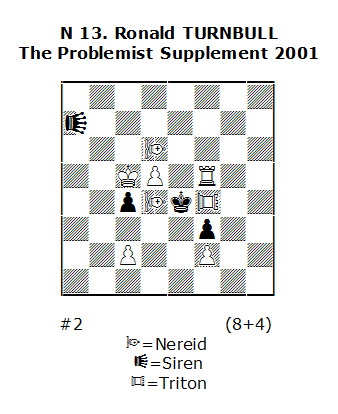
N 13. A light example – after 1.Kb4! [2.NDb6#] – the main variations with cross-checks are interesting: 1…SIa3+ 2.ND4c5#, 1…SIa5+ 2.NDc3#. Here the play of battery ND/TR is combined with fine blocks of the squares c3/c5. Additional play: 1…SIb6+ 2.NDxb6-a7#, 1…SIg7 2.NDxg7-h8#, 1…SIa1 2.NDb2#, 1…Kxd4 2.NDc5# – a surprising mate as after the Annihilation capture on d4 the move 2…Ke4?? becomes impossible because of illegal self-check!

N 14 demonstrates 4 variations with interesting self-blocks, realized by three black pieces. This combination is combined with nice unpins of the NDc4. 1.Sd4! [2.Se2#] – 1…SIg4 2.Bg5#, 1…TRg4 2.Bg3# – reciprocal self-blocks between SI and TR. 1…SIe4 2.Sd5#, 1…NEe4 2.Rf3# – reciprocal self-blocks between SI and NDc6. (1…SIf1 2.Sxg6#, 1…NDxe6-f7+ 2.Se6‡)
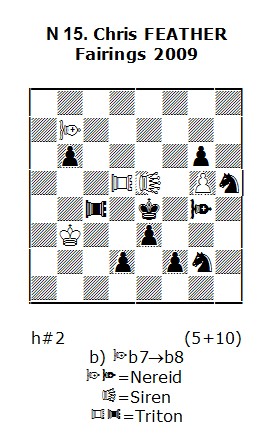
N 15 shows creation of reciprocal batteries SI/TR and TR/SI , combined with fine “Umnov” motives and “Vacation of squares”, demonstrated after moves of the NDg4 and TRc4: a) 1.NDe2 SIf5+ 2.Ke5 SIg4#; b) 1.TRa4 TRc5 2.Kd5 TRc4#.
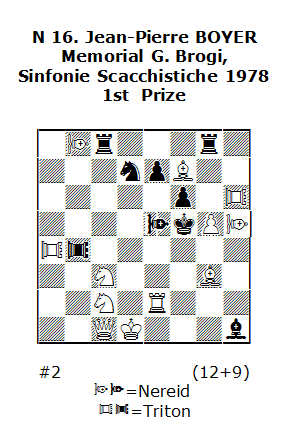
Co-work between the Triton and Nereid in N 16 give a nonstandard realization of the Lacny theme combined with Somov theme motives: Set-play: 1…TRb1 (a) 2.Sd4# (A), 1…fxg5 (b) 2.Se3# (B), 1…NExg3-h2 c 2.Be6# (C) – Real play: 1.Se4! [2.Qf4#], 1…TRb1 (a) 2.Se3# (B), 1…fxg5 (b) 2.Be6# (C), 1…NExg3-h2 (c) 2.Sd4# (A).
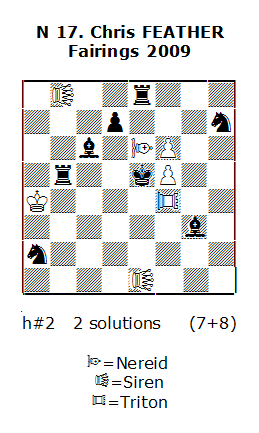
N 17. I. 1.Bxf4 SIh4 2.Ke4 SIbxf4-g3#; II. 1.Rxe6 SIg8 2.Kd5 SIxe6-e7#. An interesting destruction of the initial batteries TR/SI and ND/SI. The black captures on f4 and e6 have an Annihilation character. Good key-moves with line-opening for the white Sirens. A typical masterpiece in the Feather’s style!
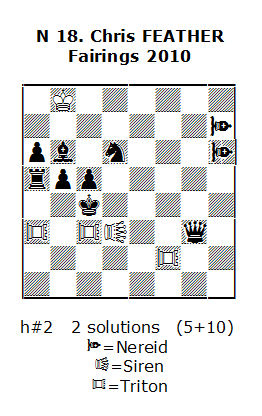
N 18. I. 1.Qg6 TRcb3 2.Kc3 SIe4#; II. 1.Qg5 SIe3 2.Kd3 SIf4#. Here we see an important idea for realization of the Umnov theme in this arena (compare with N15). The key-moves demonstrate preliminary line-closings of the black NDh6 and NDh7. After that White creates SI/TR batteries and on the mating moves closes the line of the black Queen! Excellent harmony between the three kind of Marine pieces: SI, TR, ND!
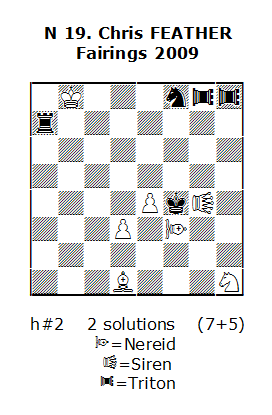
N 19. I. 1.Rh7 SIh5 2.Kg4 SIh6#; II. 1.Rg7 NEe2 2.Kf3 SIg5#. Another “Umnov” but here with play of a white SI/ND battery that is created during the play. The nice key-moves are anticipatory line closures of the black TRg8, TRg8. Without these R-moves the mates are impossible, for example: 2…SIh6+? 3.TRxh6-h5! (I sol) or 2…SIg5+? 3.TRxg5-g4! (second solution).
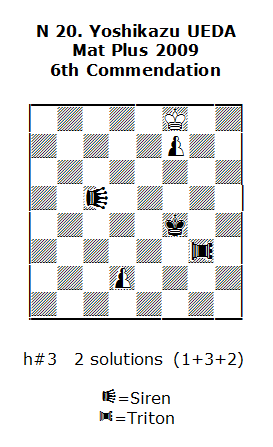
N 20. I. 1.TRf3 Kg7 2.d1=nQ f8=nTR 3.nTRf5 nQxf3#; II. 1.SIf5 Ke7 2.d1=nSI f8=nR 3.nSIf3 nRxf5#. A super-example showing unlimited possibilities in this arena, when the composer uses neutral pieces.
Of course, here the Pawn promotions are the main theme, combined also with fine pins of the mating-pieces. Another direction for fruitful play is neutral Marine batteries which is a very rarely seen phenomenon in this aspect. Unknown are examples with half-neutral Marine pieces!


Thanks to Petkov for such a nice article
Thank you M. Petkov, it is a pleasure to discover new fairy pieces with you. It gives ideas to create something new again.
After Wikipedia, Giuseppe Brogi (1900 – 1976) is the inventor of Marine pieces.
Chris Feather’s problems are mind-blowing. Thanks for the articles